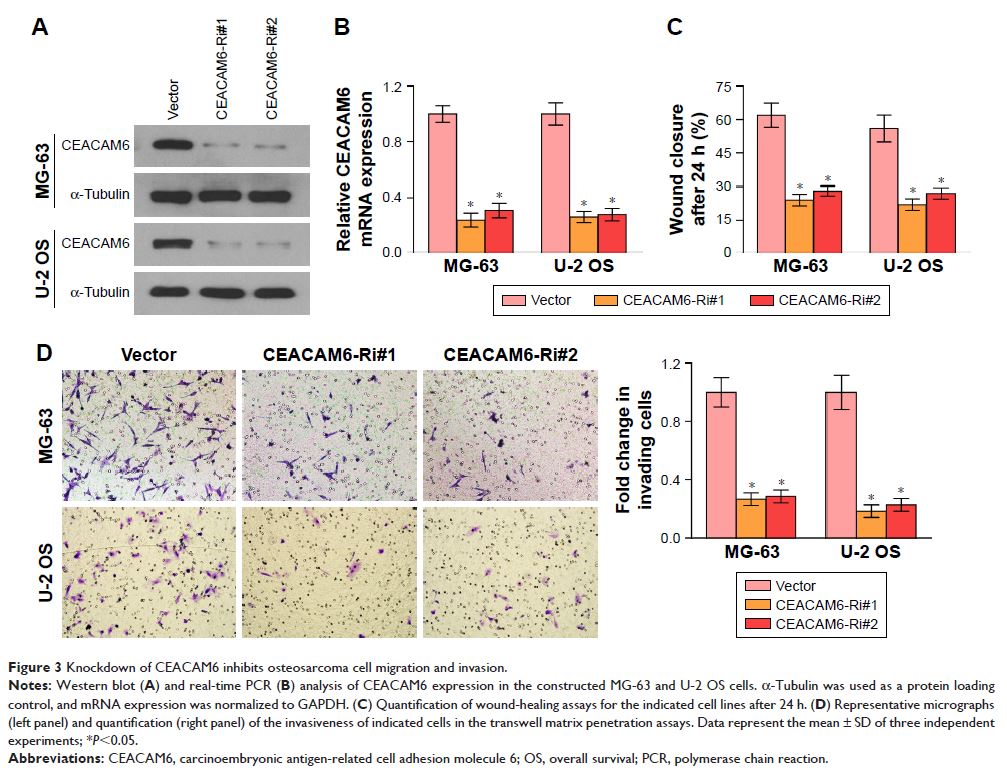108985
论文已发表
注册即可获取德孚的最新动态
IF 收录期刊
- 3.4 Breast Cancer (Dove Med Press)
- 3.2 Clin Epidemiol
- 2.6 Cancer Manag Res
- 2.9 Infect Drug Resist
- 3.7 Clin Interv Aging
- 5.1 Drug Des Dev Ther
- 3.1 Int J Chronic Obstr
- 6.6 Int J Nanomed
- 2.6 Int J Women's Health
- 2.9 Neuropsych Dis Treat
- 2.8 OncoTargets Ther
- 2.0 Patient Prefer Adher
- 2.2 Ther Clin Risk Manag
- 2.5 J Pain Res
- 3.0 Diabet Metab Synd Ob
- 3.2 Psychol Res Behav Ma
- 3.4 Nat Sci Sleep
- 1.8 Pharmgenomics Pers Med
- 2.0 Risk Manag Healthc Policy
- 4.1 J Inflamm Res
- 2.0 Int J Gen Med
- 3.4 J Hepatocell Carcinoma
- 3.0 J Asthma Allergy
- 2.2 Clin Cosmet Investig Dermatol
- 2.4 J Multidiscip Healthc

CEACAM6 与骨肉瘤转移相关并促进骨肉瘤细胞的上皮 - 间质转化
Authors Wang Z, Luo C, Wang H, Yan X, Liu W, Meng Z
Received 7 January 2018
Accepted for publication 8 April 2018
Published 28 May 2018 Volume 2018:11 Pages 3159—3166
DOI https://doi.org/10.2147/OTT.S161807
Checked for plagiarism Yes
Review by Single-blind
Peer reviewers approved by Dr Cristina Weinberg
Peer reviewer comments 3
Editor who approved publication: Dr Samir Farghaly
Background: Carcinoembryonic antigen-related cell adhesion molecule 6 (CEACAM6) is a
member of CEACAM family and has been reported to be upregulated in various
types of human cancer and involved in tumor progression and metastasis.
However, the biological roles and clinical significances of CEACAM6 in
osteosarcoma still remain to be elucidated.
Materials and
methods: Real-time PCR, immunohistochemistry
and Western blot analysis were used to determine CEACAM6 expression in
osteosarcoma cell lines and clinical specimens. Then the clinical relevance of
CEACAM6 was analyzed in osteosarcoma. The function of CEACAM6 in osteosarcoma
was examined by wound-healing and cell invasion assays, and expression levels
of epithelial–mesenchymal transition markers.
Results: In the present study, we found that CEACAM6 was markedly
upregulated in metastatic osteosarcoma tissues when compared with the
nonmetastatic osteosarcoma tissues. Upregulation of CEACAM6 was significantly
associated with lung metastasis status (P =0.006) in
patients with osteosarcoma. Survival analyses suggested that osteosarcoma
patients with high CEACAM6 expression had a significantly shorter overall
survival time and lung metastasis-free survival time than those with low
CEACAM6 expression. Knockdown of CEACAM6 inhibits osteosarcoma cell migration
and invasion. Moreover, silencing CEACAM6 suppressed osteosarcoma cells
epithelial–mesenchymal transition.
Conclusion: Taken together, this study suggests that CEACAM6 might be a
promising biomarker and a potential therapeutic target for the treatment of
metastatic osteosarcoma.
Keywords: CEACAM6, osteosarcoma, metastasis, epithelial–mesenchymal transition,
prognosis
